 W
WArabic miniatures are small paintings on paper, usually book or manuscript illustrations but also sometimes separate artworks. The earliest date from around 1000 AD, with a flourishing of the artform from around 1200 AD.
 W
WAnna Margaretta Archambault (1856–1956) was an American artist and author. She is best known for her 1924 book A Guide Book of Art, Architecture, and Historic Interests in Pennsylvania, which remains in print as of 2020.
 W
WArtist trading cards (ATCs) is a conceptual art project initiated by the Swiss artist M. Vänçi Stirnemann in 1997. He called it a Collaborative Cultural Performance. Artist trading cards are 2+1⁄2 by 3+1⁄2 inches in size, the same format as modern trading cards. They are self-made unique works or small series, signed and dated on the reverse by the artist/producer, exchanged and collected by the people who participate in the collaborative performance.
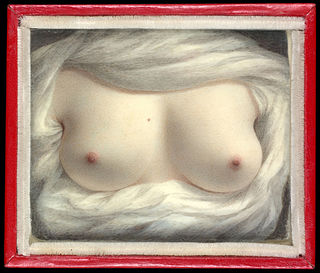 W
WBeauty Revealed is an 1828 self-portrait by the American artist Sarah Goodridge, a watercolor portrait miniature on a piece of ivory. Depicting only the artist's bared breasts surrounded by white cloth, the 6.7-by-8-centimeter painting, originally backed with paper, is now in a modern frame. Goodridge, aged forty when she completed the miniature, depicts breasts that appear imbued with a "balance, paleness, and buoyancy" by the harmony of light, color, and balance. The surrounding cloth draws the viewer to focus on them, leading to the body being "erased".
 W
WBolt Action is a miniature wargame produced by Warlord Games. It is set during World War II and uses 28mm-sized models. The game was developed by Alessio Cavatore and Rick Priestley. The first edition of the rulebook was published in 2012, and the second edition was published in 2016. Supplements for the game include: The Korean War, and Konflikt '47, set in a Dieselpunk and supernatural alternate history of World War II.
 W
WMoshe Bromberg (1920-1982) was a notable artist and sculptor.
 W
WAnna Maria Carew was an English miniature painter.
 W
WJoan Carlile or Carlell or Carliell, was an English portrait painter. She was one of the first British women known to practise painting professionally. Before Carlile, known professional female painters working in Britain were born elsewhere in Europe, principally the Low Countries.
 W
WNihâl Chand (1710–1782) was an Indian painter and poet who produced some of the best known examples of Rajput painting. He was the chief painter at the court of Kishangarh during the time of the ruler Savant Singh. He is attributed with a small group of paintings in a distinctive style, produced for Raja Savant Singh, and mostly depicting the raja and his mistress Bani Thani as Krishna and Radha. These are "widely held to be the finest of all Rajasthani miniatures", and are unusually large for their type, reaching 19 by 14 inches. He was a devout follower of Vallabha who had founded a Krishna-centric philosophy that surfaces repeatedly in his paintings as he deifies the king with light blue skin. He arrived in Kishangarh between 1719 and 1726.
 W
WChandrahasa was the king of Kuntala kingdom which roughly consisted of parts of the north of present-day Karnataka and south of Maharashtra, India, including Gokarna region. Sometimes an overlapping region Gorashtra is mentioned to be part of Kuntala. The story of Chandrahasa is mentioned in Ashvamedhika Parva of the epic Mahabharata. He was the son of the king Sudharmika of Kerala. He married Vishaye and Champakamalini who was the princess of Kuntala. They had two sons Makaraksha and Padmaksha. Chandrahasa befriends Arjuna who was accompanied by Krishna guarding the Ashvamedha horse of Yudhishthira. Chandrahasa anoints his son Makaraksha as the king and accompanies the army of Arjuna to help Ashvamedha.
 W
WThe Family of Sigismund I of Poland or Portrait Miniatures of the Jagiellon Family is a set of ten portrait miniatures of the Jagiellonian dynasty, produced in the studio of Lucas Cranach the Younger during Bona Sforza's time as queen in Poland after she had married Sigismund I of Poland, c. 1553-1555. They are all now in the Czartoryski Museum.
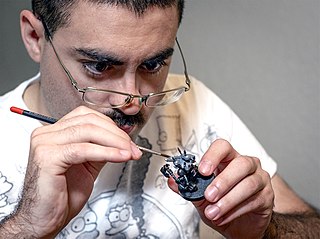 W
WFigure painting, or miniature painting, is the hobby of painting miniature figures and/or model figures, either as a standalone activity or as a part of another activity that uses models, such as role-playing games, wargames, or military modeling.
 W
WFreydal is an uncompleted illustrated prose narrative commissioned by the Holy Roman Emperor, Maximilian I in the early 16th century. It was intended to be a romantic allegorical account of Maximilian's own participation in a series of jousting tournaments in the guise of the tale's eponymous hero, Freydal. In the story, Freydal takes part in the tournaments to prove that he is worthy to marry a princess, who is a fictionalised representation of Maximilian's late wife, Mary of Burgundy.
 W
WFernando García del Molino was a Chilean-born Argentine portrait painter, miniaturist and lithographer. Many of his portraits were done from photographs or daguerrotypes.
 W
WThe Heures de Charles d'Angoulême is a book of hours commissioned in the late 15th century, probably around 1480, by Charles, Count of Angoulême, father of king Francis I of France. It is now in the Bibliothèque nationale de France in Paris, under the number Latin 1173.
 W
WJoris Hoefnagel or Georg Hoefnagel was a Flemish painter, printmaker, miniaturist, draftsman and merchant. He is noted for his illustrations of natural history subjects, topographical views, illuminations and mythological works. He was one of the last manuscript illuminators and made a major contribution to the development of topographical drawing.
 W
WCarl Ludwig Hummel, also known as Carl Ludwig Hummel de Bourdon; born Charles de Bourdon was a French-born Austrian portrait painter who specialized in miniatures.
 W
WIslamic miniatures are small paintings on paper, usually book or manuscript illustrations but also sometimes separate artworks. The earliest examples date from around 1000 AD, with a flourishing of the artform from around 1200 AD. The field is divided by scholars into four types, Arabic, Mughal (Indian), Ottoman (Turkish), and Persian.
 W
WA Kholuy miniature is a Russian folk handicraft of miniature painting, made with tempera on a varnished box of papier-mâché. This form of Russian lacquer art is produced exclusively by students of the Kholuy school.
 W
WJohann Friedrich Leybold was a German miniaturist painter and copper engraver.
 W
WLudwik Marteau, originally Louis-François Marteau was a Polish court painter who served under kings Augustus III and Stanisław August Poniatowski. All of his known works are portraits; both full size and miniatures.
 W
WThe word miniature, derived from the Latin verb miniare indicates a small illustration used to decorate an ancient or medieval illuminated manuscript; the simple illustrations of the early codices having been miniated or delineated with that pigment. The generally small scale of such medieval pictures has led to etymological confusion with minuteness and to its application to small paintings, especially portrait miniatures, which did however grow from the same tradition and at least initially used similar techniques.
 W
WMrs. Beckington is a 1913 miniature painting in watercolour on ivory by Alice Beckington. It is in the collection of the Metropolitan Museum of Art in New York.
 W
WMstyora miniature is a Russian folk handicraft of miniature painting, which is done with tempera paints on varnished articles mostly made of papier-mâché.
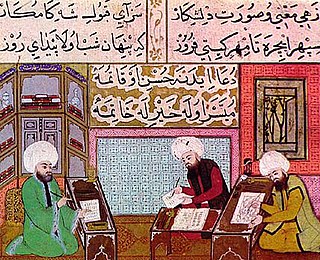 W
WOttoman miniature or Turkish miniature was a Turkish art form in the Ottoman Empire, which can be linked to the Persian miniature tradition, as well as strong Chinese artistic influences. It was a part of the Ottoman book arts, together with illumination, calligraphy, marbling paper, and bookbinding. The words taswir or nakish were used to define the art of miniature painting in Ottoman Turkish. The studios the artists worked in were called Nakkashanes.
 W
WPeter Paillou, was a British painter of portraits including miniatures.
 W
WPalekh miniature is a Russian folk handicraft of a miniature painting, which is done with tempera paints on varnished articles made of papier-mâché.
 W
WThe Passing of Shah Jahan is a Miniature painting, painted by the Indian artist Abanindranath Tagore in 1902. The painting depicts a scene in which the fifth Mughal Emperor Shah Jahan stares upon the Taj Mahal on his deathbed, with his daughter at his feet. Initially involved with the dominant style of European Naturalism, Tagore's mentor Ernest Binfield Havell had introduced him to various types of Indian art. Of these varieties, Tagore was most impressed with old Mughal miniatures, which often featured emotionless, but detailed illustrations of scenes and characters. Incorporating this style with the traditional Indian artistic concept of Bhava', or emotion, Tagore had painted a scene based upon the growing re-interest in Indian history during the British Raj.
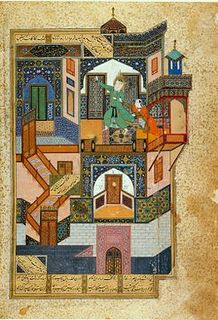 W
WA Persian miniature is a small Persian painting on paper, whether a book illustration or a separate work of art intended to be kept in an album of such works called a muraqqa. The techniques are broadly comparable to the Western Medieval and Byzantine traditions of miniatures in illuminated manuscripts. Although there is an equally well-established Persian tradition of wall-painting, the survival rate and state of preservation of miniatures is better, and miniatures are much the best-known form of Persian painting in the West, and many of the most important examples are in Western, or Turkish, museums. Miniature painting became a significant genre in Persian art in the 13th century, receiving Chinese influence after the Mongol conquests, and the highest point in the tradition was reached in the 15th and 16th centuries. The tradition continued, under some Western influence, after this, and has many modern exponents. The Persian miniature was the dominant influence on other Islamic miniature traditions, principally the Ottoman miniature in Turkey, and the Mughal miniature in the Indian sub-continent.
 W
WA portrait miniature is a miniature portrait painting, usually executed in gouache, watercolor, or enamel. Portrait miniatures developed out of the techniques of the miniatures in illuminated manuscripts, and were popular among 16th-century elites, mainly in England and France, and spread across the rest of Europe from the middle of the 18th century, remaining highly popular until the development of daguerreotypes and photography in the mid-19th century. They were usually intimate gifts given within the family, or by hopeful males in courtship, but some rulers, such as James I of England, gave large numbers as diplomatic or political gifts. They were especially likely to be painted when a family member was going to be absent for significant periods, whether a husband or son going to war or emigrating, or a daughter getting married.
 W
WPyotr Fyodorovich Sokolov was a Russian aquarelle portraitist who painted many of the most distinguished figures of the Pushkin era. He was the father of the painters Pyotr Sokolov, Pavel Sokolov and Alexander Sokolov.
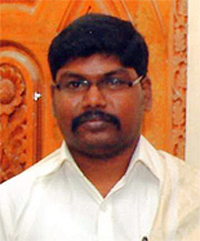 W
WGunasekaran Sundarraj is an Indian Miniature artist known for his talent in painting and sculpting on grains and articles like grains of rice, mustard, sago, poppy seeds, pencil tips and anything that catches his attention. His talent has led to a number of achievements in Miniature Art. In the year 2012, he won the Sardar Patel Awards, an International Award. He was honored with the title of 'Shri' recently.
 W
WÉlisabeth Terroux (1759–1822) was a Swiss painter active in Russia.
 W
WAdolf Theer was an Austrian portrait painter and lithographer.
 W
WAlbert Theer was an Austrian portrait painter and lithographer.
 W
WHenry Tanworth Wells was an English miniature and portrait painter. He was a member of the Pre-Raphaelite circle though he painted in the academic style.